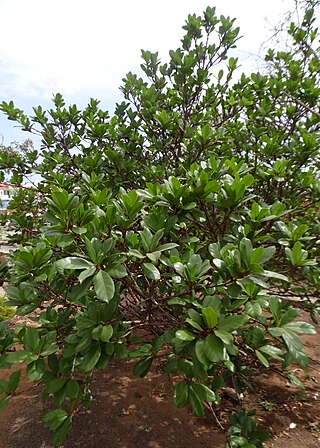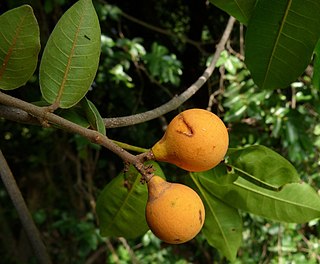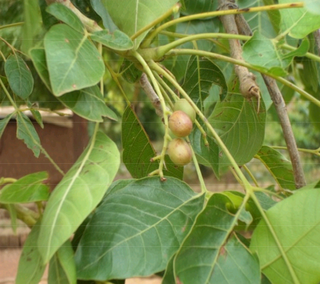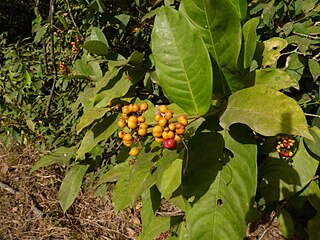
Ficus is a genus of about 850 species of woody trees, shrubs, vines, epiphytes and hemiepiphytes in the family Moraceae. Collectively known as fig trees or figs, they are native throughout the tropics with a few species extending into the semi-warm temperate zone. The common fig (F. carica) is a temperate species native to southwest Asia and the Mediterranean region, which has been widely cultivated from ancient times for its fruit, also referred to as figs. The fruit of most other species are also edible though they are usually of only local economic importance or eaten as bushfood. However, they are extremely important food resources for wildlife. Figs are also of considerable cultural importance throughout the tropics, both as objects of worship and for their many practical uses.

Ficus macrophylla, commonly known as the Moreton Bay fig or Australian banyan, is a large evergreen banyan tree of the Mulberry Family (Moraceae) native to eastern Australia, from the Wide Bay–Burnett region in the north to the Illawarra in New South Wales, as well as Lord Howe Island where the subspecies F. m. columnaris is a banyan form covering 2.5 acres or more of ground. Its common name is derived from Moreton Bay in Queensland, Australia. It is best known for its imposing buttress roots.

Ficus citrifolia, also known as the shortleaf fig, giant bearded fig, Jagüey, wild banyantree and Wimba tree, is a species of banyan native to southern Florida, the Caribbean, Mexico, Central America, and northern South America south to Paraguay. It is distinguished from the closely related Florida strangler fig mainly by the finer veining in the leaves.

Ficus thonningii is a species of Ficus. It is native to Africa. It is commonly known as Mugumo to the Agikuyu or the Strangler Fig in common English. Recent phylogenetic analysis suggests it may be a species complex.

Ficus aurea, commonly known as the Florida strangler fig, golden fig, or higuerón, is a tree in the family Moraceae that is native to the U.S. state of Florida, the northern and western Caribbean, southern Mexico and Central America south to Panama. The specific epithet aurea was applied by English botanist Thomas Nuttall who described the species in 1846.
Ficus maxima is a fig tree which is native to Mexico, Central America, the Caribbean and South America south to Paraguay. Figs belong to the family Moraceae. The specific epithet maxima was coined by Scottish botanist Philip Miller in 1768; Miller's name was applied to this species in the Flora of Jamaica, but it was later determined that Miller's description was actually of the species now known as Ficus aurea. To avoid confusion, Cornelis Berg proposed that the name should be conserved for this species. Berg's proposal was accepted in 2005.

Ficus pleurocarpa, commonly known as the banana fig, karpe fig or gabi fig, is a fig that is endemic to the wet tropical rainforests of northeastern Queensland, Australia. It has characteristic ribbed orange and red cylindrical syconia. It begins life as a hemiepiphyte, later becoming a tree up to 25 m (82 ft) tall. F. pleurocarpa is one of the few figs known to be pollinated by more than one species of fig wasp.

Ficus platypoda, commonly known as the desert fig or rock fig, is a fig that is endemic to central and northern Australia. It is a lithophytic plant that grows on rocky outcrops, reaching 10 m in height.

Ficus obliqua, commonly known as the small-leaved fig, is a tree in the family Moraceae, native to eastern Australia, New Guinea, eastern Indonesia to Sulawesi and islands in the southwestern Pacific Ocean. Previously known for many years as Ficus eugenioides, it is a banyan of the genus Ficus, which contains around 750 species worldwide in warm climates, including the edible fig. Beginning life as a seedling, which grows on other plants (epiphyte) or on rocks (lithophyte), F. obliqua can grow to 60 m (200 ft) high and nearly as wide with a pale grey buttressed trunk, and glossy green leaves.

Ficus sur, with the common names Cape fig and broom cluster fig, is a widespread Afrotropical species of cauliflorous fig.

Ficus ingens, the red-leaved fig, is a fig species with an extensive range in the subtropical to dry tropical regions of Africa and southern Arabia. Despite its specific name, which means "huge", or "vast", it is usually a shrub or tree of modest proportions. It is a fig of variable habit depending on the local climate and substrate, typically a stunted subshrub on elevated rocky ridges, or potentially a large tree on warmer plains and lowlands. In 1829 the missionary Robert Moffat found a rare giant specimen, into which seventeen thatch huts of a native tribe were placed, so as to be out of reach of lions.

''Ficus cyathistipula'', the African fig tree, is a species of fig that is native to the tropical forest regions of Africa. They may be small trees, shrubs or hemi-epiphytic lianas, and are widespread in the moist tropics, where they may be found in Afromontane or rainforest, often overhanging pools. The figs are reddish when ripe, and have thick, spongy walls that enable them to float on water. They are named for their cup-shaped (cyathus-) and persistent stipules (stipula).
Senegalia dudgeonii is a small perennial tree that grows up to 9 meters tall. It belongs to the Fabaceae family and endemic Sudano-Sahelian and Guinea savannah zones of West Africa.

Landolphia heudelotii is a climbing shrub or liana that is within the Apocynaceae family, it occurs in the Guinea and Sudan savannahs of West Africa and cultivated for its rubber and edible fruit.

Gardenia erubescens is a shrub or small tree species with edible fruits that occurs in the Guinea and Sudan savannah vegetation of West and Central Africa. It is within the Rubiaceae family.

Lannea acida is a shrub or small deciduous tree within the family Anacardiaceae. It is endemic to the Guinea and Sudan savannas of West and Central Africa.

Lannea microcarpa is a dioecious plant within the Anacardiaceae family. It is also called African grapes and occurs in the Sudan and Guinea savanna of West Africa from Senegal to Cameroon. The plant is used to dye basilan fini, a traditional cloth in a red and brown colour.

Berlinia grandiflora is a small to medium sized tree found in the West and West Central African region along riparian habitats or gallery forests habitat types.
Ficus mucuso is a medium to large sized tree within the family Moraceae. The range of the species spans Tropical West Africa from Sierral Leone to Uganda, in East Africa.

Ixora brachypoda is a species of shrub or small tree in the family Rubiaceae. It has fragrant flowers and glabrous leaves and stems.

















